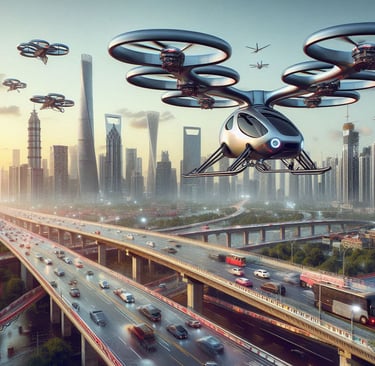Modular Flying Cars and Future Urban Transportation
Priyanshu - Bit Wise Reviews
9/19/2025


Introduction
Modern urban transportation research will undergo a fundamental shift because modern consumers access newly developed technologies that incorporate electric vehicles, autonomous vehicles, and hyperloop systems. The advancement in smart mobility originates from modular systems because these systems make vehicle flight operations possible. The next-gen eVTOL aircraft uses a modular architecture as a system, enabling easy transitions from terrestrial to aerial travel.
Support: Airbus CityAirbus / eVTOL program (prototype & modular eVTOL research)
(Source: CityAirbus NextGen (Airbus) )
“Aeronautical technology coupled with automotive methods enables modular flying vehicles…”
(Source: Advanced Air Mobility (AAM) overview)
Three main conditions of megacities serve as the focus of flying vehicle development for city travel: improved travel efficiency and better environmental performance, combined with improved transportation organization. First, the article examines modular flying car engineering systems, followed by an assessment of the benefits and difficulties, combined with a review of their effects on urban transportation.
The Concept of Modular Flying Cars
Modular flying cars are innovative vehicles that should be capable of operating both as ordinary road cars and as planes. They can achieve this two-fold ability by having removable flight units, which means that the vehicles can change shape in short periods of operation, transitioning between forms.
Key Operational Features
Operating a modular flying car is based on two major sets of features that allow it to move both on the ground and in the air:
Dual-Mode Operation: These cars are used as a road car and an aircraft at the same time.
For real-world examples of dual-mode / convertible vehicles (AirCar)
(Source: Aircar – The Flying Car Passed Flight Tests. Next Stop: Driving a New Market)
Vertical Takeoff and Landing (VTOL): They are not necessitated by long runways, and they are best applied in the urban setting.
"Airbus eVTOL pages and FAA vertiport guidance"
(Source: CityAirbus NextGen)
Sustainable Power: These cars have electric-powered engines and have sustainable energy systems that will result in a dramatic decrease in carbon pollution.
AI-Powered Navigation: They have self-driving flight systems to guarantee high safety and efficiency when flying.
Also Read: AI-powered Household Robots Transforming Domestic Chores
Advantages of Modular Flying Cars in Urban Transportation
1. Reduced Traffic Congestion
Heavy traffic congestion affects all three cities of New York City, Los Angeles, and Tokyo simultaneously.
The presence of air corridors allows flying cars to use airspace above standard traffic to provide significant reductions in journey time.
2. Travel time reductions
Operational vehicles make use of dual driving and flying systems to deliver travel time reductions exceeding 70% or 50%.
The flying mode reduces travel time from ninety minutes of surface driving to twenty minutes of flight.
3. Sustainable and Eco-Friendly Transportation
These electric flying vehicles emit no emissions through their propulsion system.
Using aircraft systems that use fossil fuel transportation enables societies to establish carbon-neutral metrics.
4. Smart City Integration
The implementation of Artificial Intelligence tracking systems with smart traffic systems creates outstanding opportunities for managing urban airspace as well as implementing flying vehicles.
IoT communication technology uses the exchanged data to establish improved safety measures for traffic control systems.
5. Versatile Mobility Solutions
This vehicle technology provides solutions to four primary functions, including personal use alone with roadside sharing and medical emergencies, and utility distribution operations.
Flying taxi services implemented by businesses enable better urban transportation networks to become accessible for their operations.
"For studies on potential travel-time savings and caveats, link to NASA AAM and peer-reviewed research (MDPI / Springer)"
(Source: NASA AAM: travel-time potential )
Challenges of Modular Flying Cars
1. High Development Costs
Advanced aeronautical engineering drives up complete manufacturing expenses for modular flying vehicles since developers integrate it into their production techniques.
At present, only organizations possessing great financial capacity, alongside corporations, maintain access to these innovation resources.
2. Regulatory and Legal Hurdles
Nationwide authorities must set official rules to define aviation rules for operating these vehicles.
Different operational systems require updated official laws from the aviation and automobile sectors to function properly with one another.
3. Infrastructure Development
Municipalities need to build essential aviation control systems alongside sufficient flying vehicle charging facilities for the successful operation of vertiports.
Flying cars cannot reach the public market until cities work on creating the essential infrastructure needed to support their operation.
4. Safety Concerns and Public Acceptance
For operational flying cars to be effective, they must have systems that avoid all types of accidents when flying in heavy traffic airspace.
People will take time to believe in aircraft flight systems with no human operators on board.
Various technical and aerospace corporations currently develop modular flying car systems to transform urban transportation methods.
The development of modular flying cars continues to advance under several organizations specializing in aerospace technology and tech development to transform urban transportation systems.
"Link to EASA and FAA regulatory pages and to UK / gov evidence reviews on AAM"
(Source: EASA UAM regulatory work )
Read More: Gaming Laptop vs. Cloud Gaming: Which is Right for You in 2025?
Companies Driving Development
The modular and dual-mode flying car market is a very competitive environment, which is pushed by innovative start-ups and large automotive companies.
Where XPENG Aeroht has been the first to follow the truly detachable modular concept, other firms are the first to take the integrated roadable aircraft approach.
Indeed, Modular (Detachable Systems).
1. XPENG Aeroht (Aridge) (China):
Idea: The Land Aircraft Carrier is a removable system comprising a 6-wheel pickup automobile (the "mothership) and a two-seat eVTOL aircraft module.
Status: Started trial production at the first mass-production flying car factory in the world in November 2025; mass production and customer delivery should occur in 2026.
Source:
Milestone in Trial Production Hindu
Product Information:
eVTOL.news (XPENG AeroHT Modular Flying Car).
2. GAC Group (Govy) (China):
Concept: Inventing the Govy AirCar, the detachable passenger eVTOL flight pod, which can detach to an autonomous roadable chassis.
Good news! The system is accelerating and has already completed over 400 flight tests and received a special commercial flight permit at the end of last year (2024). The company is currently working on making the system fully available for commercial usage by the year 2027.
Source:
Products and trial:
eVTOL.news (GAC Group Govy AirCar).
Company Web:
Transforming Systems Integrated Roadable Aircraft.
3. Alef Aeronautics (USA):
Idea: The Model A is a fully electric car that drives on the road (with an unlimited speed) and flies up in the air by rotating its whole body vertically.
Status: Has an FAA Special Airworthiness Certificate to make limited test flights in the United States and has already obtained major pre-orders of its model, with the initial delivery of the aircraft estimated towards the end of 2025.
Source:
Alef Aeronautics Official Site.
FAA Certification Wikipedia (Alef Aeronautics)
4. PAL-V International (Netherlands):
Idea: The PAL-V Liberty is a 3-wheeled vehicle that transforms into an autogyro/gyrocopter by folding down the rotors and tail.
Status: Achieved necessary European Road Admission to use on streets and is working on final flight certification at the beginning of customer deliveries, which have been estimated to take place in 2026.
Source:
Product Specification:
PAL-V official site (The Liberty).
Technical Specs:
The Future Of Modular Flying Cars
The next decade, together with the subsequent ten years, will deliver vital developments to flying car technology until it reaches full safety standards and operational readiness.
1. AI and Autonomous Navigation Systems
A network of computer systems establishing control with artificial intelligence will oversee the traffic management for flying vehicles throughout urban areas.
Both takeoff operations and flights, together with landing procedures, will be managed by autonomous navigation systems.
AI & Autonomous Navigation Systems → NASA Advanced Air Mobility Playbook
2. Integration with Smart Cities
Urban landing zones known as Vertiports will be built into municipal infrastructure through city planner design.
The operation of flying vehicles will link with automated electric vehicles and smart public transportation systems as part of their service.
3. Advanced Battery and Fuel Technology
Future flying vehicles will unite hydrogen fuel cells and solid-state batteries to extend their flight range.
Better battery technology enables aircraft to travel more than 200 miles without requiring a battery recharge.
Advanced Battery & Fuel Technology →
4. Public and Commercial Adoption
Flying taxis, personal air vehicles, and corporate fleets will appear on the market to boost urban mobility.
Uber Air and Lilium Aviation operate with other firms to test the present air taxi service model.
5. Affordability and Mass Adoption
The advancement of technology will reduce costs, so flying cars will become available to the general public.
Flight vehicles become available through service systems provided by faring companies, even though their customers do not purchase ownership.
Read More: Smart indoor gardening solutions with AI-powered planters
Conclusion
The future of urban transportation has entirely shifted because flying cars offer both fast, environmentally friendly performance and better performance than traditional land-based vehicles. These vehicles will advance people and goods transportation through their AI-directed navigation system while establishing smart platforms with sustainable energy distribution in the near future.
Flight vehicles will shorten both transportation delays and travel times.
Sustainable electric and hydrogen-powered engines used together present a method to decrease carbon emissions.
AI systems currently managing air traffic operations serve as a protective system for aircraft flight safety.
The main requirement involves solving regulatory barriers alongside infrastructure development needs.
The market-wide adoption of flying cars will commence during the subsequent ten to twenty years.
Scientific fiction about flying cars initially belonged to theoretical speculation, but it is now becoming real technology through active development. The launch of future urban mobility infrastructure will become possible through corporate advancements in modular aerial vehicles with efficient and affordable designs
I think that the real challenge in the future is neither technology nor regulation. The most obvious sign that global transit authorities are already thinking of this transition is the fact that companies such as Alef Aeronautics and PAL-V have already acquired special road and air permits. Personally, I believe that someday, in the next five years, the view of a dual-mode vehicle of either detaching or transforming into something will be a normal, anticipated appearance in the city.
About The Author
Hey there! I’m Priyanshu, the founder and editor behind Bit Wise Reviews — a platform dedicated to making technology easy to understand for everyone.
I started this website with a simple idea:
“Tech doesn’t have to be complicated — it just needs to be explained the right way.”
INSIGHTS
Your go-to source for latest tech gadgets news
Support
Connect
© 2025. Bit Wise Reviews
+91 6377810443
Quick Links
